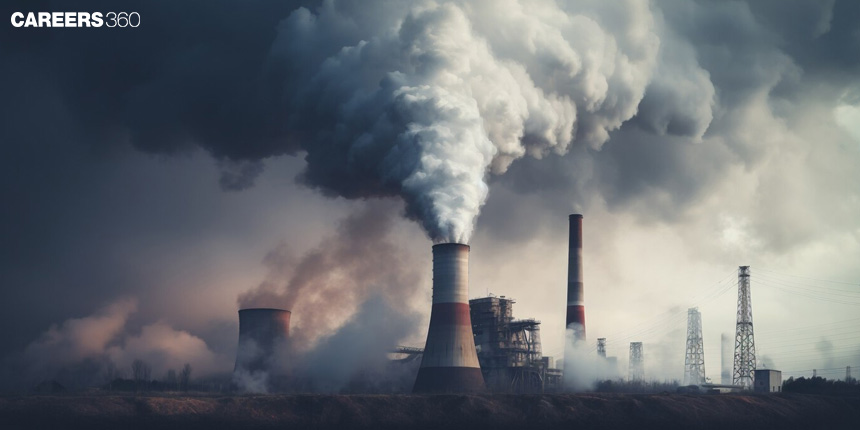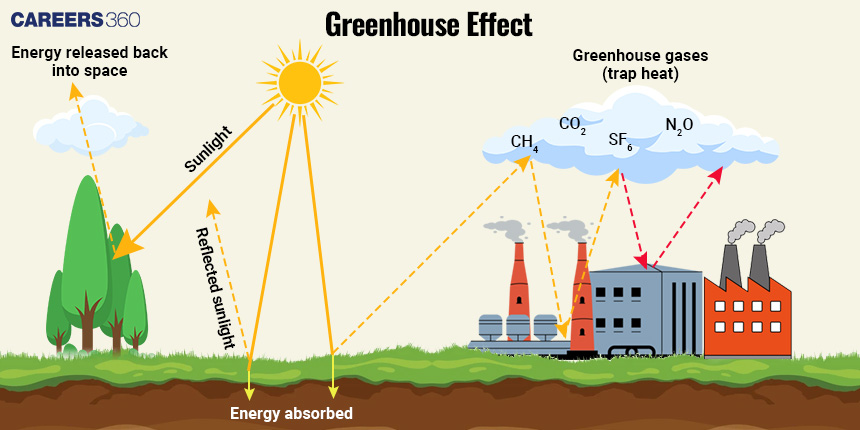Greenhouse Effect: Definition, Meaning, Diagram, Examples, Facts, Causes, Effects
The greenhouse effect is a natural process that helps keep the Earth warm enough to support life. It happens when greenhouse gases, like carbon dioxide and methane, secure heat from the Sun in the Earth's atmosphere, preventing it from escaping back into space. While essential for the maintenance of the planet's temperature, an increase in these gases due to human activities has intensified the greenhouse effect, leading to global warming. In this article, the greenhouse effect definition, the greenhouse effect, diagram of the greenhouse effect, greenhouse gases, causes of the greenhouse effect, effects of the greenhouse effect, runaway greenhouse effect, and mechanism of the greenhouse effect are discussed. The greenhouse effect is a topic of Environmental Issues in Biology.
This Story also Contains
- Greenhouse Effect Definition
- What is the Greenhouse Effect?
- Diagram of Greenhouse Effect
- Greenhouse Gases
- Causes of Greenhouse Effect
- Effects of Greenhouse Effect
- Runaway Greenhouse Effect
- Mechanism of the Greenhouse Effect
- Greenhouse Gases and their Sources
- Recommended Video on The Greenhouse Effect:

Greenhouse Effect Definition
The greenhouse effect refers to the process by which certain gases in Earth's atmosphere trap heat, preventing it from escaping into space. This natural phenomenon is essential for maintaining Earth's temperature, but human activities, such as burning fossil fuels, have intensified it, leading to global warming and climate change.
What is the Greenhouse Effect?
The greenhouse effect is a naturally occurring process that plays the important role of ensuring that the Earth maintains the correct temperatures for life to be sustained. It is a process by which some gases in the atmosphere interact with incoming energy from the sun. The sun is supposed to send its rays to the surface and be reflected into space, but it warms the Earth's surface instead, meaning the heat is radiated. Part of it gets to be diffused back into space, but some bit is retained by the greenhouse gases in the atmosphere. This trapped heat acts like an insulative blanket draped over the planet's surface, keeping it warmer than it would otherwise, thereby maintaining a stable climate fit for life.
In reality, without the greenhouse effect, Earth would have been comparatively much colder, with mean temperatures below freezing. But man-induced activities, namely the combustion of fossil fuels and deforestation have bulged the amount of greenhouse gases in the atmosphere. The intensification of the greenhouse effect has resulted in an effect known as global warming. Increasing levels of gases mean that more heat will be retained, thus intensifying temperature across the globe. This heating trend is disruptive to rational climate patterns and brings more frequent and intense weather events, rising sea levels, and endangers ecosystems and human communities worldwide.
Diagram of Greenhouse Effect

Greenhouse Gases
Greenhouse gases are gases in Earth's atmosphere that trap heat, contributing to the greenhouse effect and warming the planet. The main greenhouse gases include carbon dioxide (CO2), methane (CH4), nitrous oxide (N2O), and fluorinated gases. Human activities, such as burning fossil fuels, deforestation, and industrial processes, have significantly increased the concentration of these gases in the atmosphere, intensifying the greenhouse effect and driving climate change.
Also Read-
Causes of Greenhouse Effect
Mainly, the greenhouse effect results from human activities and natural processes that alter the composition of Earth's atmosphere. It is a natural process that sustains a livable climate on Earth by allowing certain gases—carbon dioxide, methane, water vapour, and others—to absorb and re-emit infrared radiation and trap heat in the atmosphere, thus warming the planet's surface. The causes of the greenhouse effect are discussed as follows-
Human Activities
However, human activities have magnified this greenhouse effect to a very great extent by increasing these gases' concentration. Huge amounts of CO2 are emitted into the atmosphere by the burning of fossil fuels for energy, industrial processes, and transportation. Deforestation, especially for agriculture and the growth of cities, shrinks the ability of the Earth to consume more CO2 through photosynthesis and overweight the level of greenhouse gases.
Methane Emissions
The other major cause of the enhanced greenhouse effect is methane emissions, mainly from agriculture (enteric fermentation in livestock and rice cultivation) and extraction/transportation of fossil fuel energy sources such as natural gas. Methane is a far more efficient GHG at trapping heat than CO2 over shorter timescales. Other gases include nitrous oxide, from agricultural and industrial activity, and fluorinated gases, which are used in refrigeration and air conditioning, and together these all contribute to the enhanced greenhouse effect.
Natural Processes
Natural events, like volcanic eruptions and fires, can also emit these gases, but the magnitude is generally very small compared with human activities. Land-use change, urbanisation and industrialisation also alter atmospheric dynamics, which in turn impacts the balance of gases that regulate how much heat is retained
Effects of Greenhouse Effect
The greenhouse effect results from both human activities and natural processes of the Earth's atmosphere. Fundamentally, it is a process that sustains Earth's livable climate by allowing certain gases—carbon dioxide, methane, water vapour, and others—to absorb and re-emit infrared radiation, thereby trapping heat in the atmosphere, and warming the planet's surface. The effects of the greenhouse effect are discussed as follows-
Human Activities
However, human activities have amplified this greenhouse effect to a very great extent by increasing these gases concentration. Huge amounts of CO2 are emitted into the atmosphere due to the burning of fossil fuels for energy, industrial processes, and transportation. Deforestation, mainly due to agriculture and the growth of cities, shrinks the ability of the Earth to consume more CO2 through photosynthesis and overweight the level of greenhouse gases.
Methane Emission
Other major sources of the enhanced greenhouse effect are methane emissions from agriculture, on the one hand, and extraction/transportation of fossil fuel energy sources like natural gas on the other. Methane is an even more efficient GHG at trapping heat than CO2 over shorter timescales. Other gases involved include nitrous oxide, which is derived from agricultural and industrial activity; fluorinated gases, used in refrigeration and air conditioning; all together, these contribute to the enhanced greenhouse effect.
Natural Processes
Natural events, such as volcanic eruptions and fires, can also emit these gases; however, again, the magnitude is normally very small compared to that of human activities. Land-use change, urbanisation, and industrialisation also alter the dynamics of the atmosphere, hence having an impact on that precarious balance of gases that regulates how much heat is retained.
Runaway Greenhouse Effect
The runaway greenhouse effect is a self-enhancing cycle of heating, wherein the temperature increase acts as a catalyst for accelerating greenhouse gas emissions, thereby raising further temperatures.
Definition: It is a severe process of climate warming that cannot be controlled.
Cause: Excessive greenhouse gas emissions trap heat.
Feedback Loop: Warming releases more greenhouse gases, which cause more warming.
Results: Might give rise to very extreme, inhospitable conditions, as exists on Venus.
Prevention: Reduction of greenhouse gas emissions and mitigation of climate change impacts.
Mechanism of the Greenhouse Effect
The greenhouse effect occurs when certain gases in Earth's atmosphere, such as carbon dioxide (CO2), methane (CH4), and water vapour, absorb and re-radiate infrared radiation emitted by the Earth's surface. These gases act like a thermal blanket, trapping heat and warming the planet. CO2, due to its abundance and long-lasting presence in the atmosphere, is particularly significant in this process. Methane is more potent per molecule but less abundant, while water vapour, despite its variability, amplifies the warming effect of other greenhouse gases. Understanding these mechanisms helps us grasp how human activities contribute to climate change and guides efforts to mitigate its impacts.
Greenhouse Gases and their Sources
Carbon dioxide (CO2): Primarily sourced from burning fossil fuels (coal, oil, natural gas), deforestation, and industrial processes. CO2 contributes significantly to the greenhouse effect due to its long atmospheric lifetime, leading to gradual warming trends over time.
Methane (CH4): Main sources include agriculture (livestock digestion, rice paddies), fossil fuel production and use (natural gas leaks, coal mining), and landfills. Methane has a potent warming effect but breaks down faster than CO2. Its reduction is crucial for mitigating short-term climate impacts.
Water vapour: Naturally present in the atmosphere and highly variable based on temperature and regional conditions. While not directly controlled by human activities, its role amplifies the effects of other greenhouse gases, influencing weather patterns and climate dynamics.
Other greenhouse gases (nitrous oxide, fluorinated gases): Nitrous oxide (N2O) comes from agricultural practices, industrial activities, and biomass burning. Fluorinated gases (such as HFCs used in refrigeration) are synthetic compounds with high global warming potential. These gases contribute to the greenhouse effect in varying degrees and require targeted strategies for reduction and management.
Also Read-
Recommended Video on The Greenhouse Effect:
Frequently Asked Questions (FAQs)
The greenhouse effect is the process by which certain gases in Earth's atmosphere trap heat, warming the planet's surface. It's crucial for maintaining a habitable climate by preventing heat from escaping into space.
Greenhouse gases like carbon dioxide (CO2), methane (CH4), and water vapour absorb and re-radiate infrared radiation, trapping heat in the atmosphere. Increased concentrations of these gases from human activities intensify the greenhouse effect, leading to global warming.
Human activities such as burning fossil fuels, deforestation, and industrial processes release large amounts of greenhouse gases into the atmosphere. These emissions increase the concentration of gases like CO2 and methane, amplifying the greenhouse effect beyond natural levels.
The greenhouse effect contributes to climate change by raising global temperatures, altering weather patterns, causing sea level rise, and impacting ecosystems and biodiversity. These changes pose risks to human societies and natural environments worldwide.
Individuals can reduce their carbon footprint by using energy more efficiently (e.g., using energy-efficient appliances, reducing vehicle emissions), supporting renewable energy sources, reducing waste, and advocating for policies that promote sustainability and greenhouse gas reduction efforts.